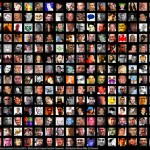This week in LIBR 599M, we were asked: Is aggregation a new role for librarians? Haven’t we always gathered, organized and used classification systems, integrated information? If we take aggregation to mean a combination or composite of date from a number of sources, then I tend to agree that aggregation is not a new phenomenon for librarians. Using this definition, traditional tools of librarianship like indexes, encyclopedias, and even subject guides can be described as aggregated content.
In what ways has Web 2.0 changed the ways in which information is aggregated? I see three important differences (although there are probably others):
- The kind of information that is being aggregated has shifted – user-generated web content has become increasingly significant
- The speed with which information can be aggregated has dramatically increased
- And, although this is more debatable, I would argue that who is doing the aggregating may be shifting. That is, users, rather than librarians, are aggregating their own information.
Now, I’m not suggesting that people have never created their own personal learning tools and that this has always been done by information professionals. That’s not true. But the new reality is that what used to take years to compile might now take only minutes. This massive shift in speed and ease, combined with a substantial change in the amount and type of content out there, means that increasingly I think people are finding their own ways to pull together the information they need, rather than requiring the library to do it for them (and I am making an enormous generalization here which is certainly true of everyone). Now, after suggesting that aggregation has historically been a role of libraries, I don’t mean that this is no longer the case. In the recent CARL/ARBC environmental scan of academic libraries which I assisted with, RSS feeds were the only tool we found to be used by every single library we looked at, and I’m sure these feeds are incredibly valuable. But I would also guess that a not-insignificant number of students and faculty at these universities also use personal RSS feeds to aggregate self-selected content. These feeds are personally tailored to the interests of each individual user.
Let’s take my own RSS feeds as an example. There’s a lot of stuff about libraries in there, but also updates from The Sartorialist, friends’ blogs, and music reviews. No library in the world would provide me with this exact mix in a single feed – but I easily have the power to create it myself. When I really want to point out here is that there is a difference between my personal aggregated content and that mediated by others. As Lorcan Dempsey writes, “One clear development is a blurring of our social, business, learning and educational lives as the pattern of our communication and interaction across time and space changes.” Both self-selected and mediated content can be very valuable, but they likely serve slightly different functions. So maybe part of the real power of Web 2.0 is (bad joke alert) the possibility of having your aggregated cake, and reading it too. For libraries, we need to know how to use new tools to access new information, but it’s clear that we can also have a role in teaching our users how to do the same.
